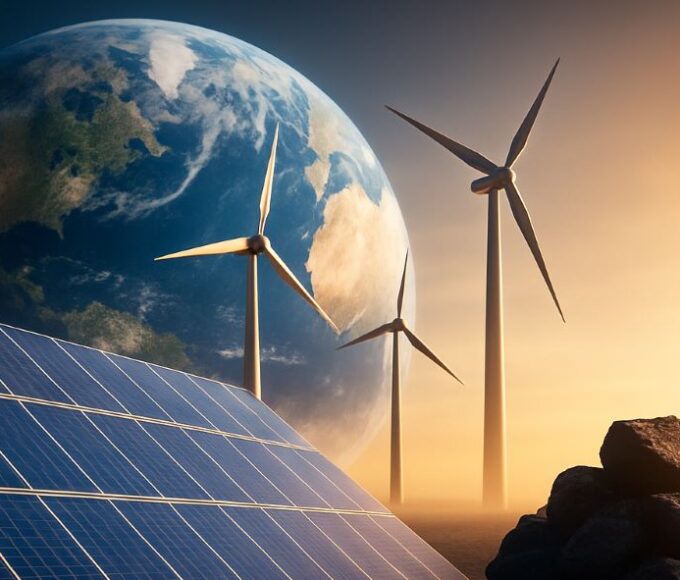As the world grapples with the undeniable impacts of climate change, the shift toward renewable energy has become a central focus of the global energy conversation. Fossil fuels, once the backbone of industrialized societies, are now viewed as a significant contributor to greenhouse gas emissions and global warming. The transition to cleaner, renewable sources of energy is seen not only as an environmental necessity but also as an economic opportunity.
In recent years, solar and wind power have experienced dramatic growth. The cost of producing solar panels and wind turbines has dropped significantly due to technological advancements and economies of scale, making these renewable sources more competitive with traditional fossil fuels. According to the International Renewable Energy Agency (IRENA), the cost of solar photovoltaic (PV) energy has fallen by over 80% in the past decade. Similarly, the efficiency of wind energy systems has improved, allowing for more energy to be generated in a smaller footprint.
Countries like China, Germany, and the United States have led the charge in renewable energy adoption. China, the world’s largest emitter of carbon dioxide, has also become the largest producer and consumer of solar power. In 2020, China accounted for over 30% of the global renewable energy capacity. Meanwhile, European nations, particularly in Scandinavia, have been pioneers in integrating wind and hydroelectric power into their energy grids. The United States, although initially slow in adopting renewables, has made significant strides, particularly in solar energy, with states like California leading the way.
A major breakthrough in renewable energy has been the development of energy storage technologies. Batteries, for instance, are now being used to store solar and wind energy for use when the sun isn’t shining or the wind isn’t blowing. Innovations in grid integration and energy storage are making renewable energy sources more reliable, and some regions are even achieving 100% renewable energy on certain days.
Energy Efficiency and Innovation in Smart Technologies
While transitioning to renewable energy is essential, improving energy efficiency remains just as critical in the fight against climate change. Energy efficiency measures, such as more efficient heating and cooling systems, LED lighting, and better insulation, can significantly reduce the overall demand for energy. According to the International Energy Agency (IEA), energy efficiency improvements are expected to account for nearly 40% of the reductions in energy-related carbon emissions by 2040.
In the realm of smart technologies, the rise of the Internet of Things (IoT) has opened up new opportunities for managing energy use more effectively. Smart thermostats, for example, allow homeowners to adjust their energy consumption remotely, learning from past behavior to optimize energy use in real time. This not only saves money but also reduces overall energy demand.
Smart grids are another innovation that promises to transform the way energy is distributed and consumed. These grids are more efficient, resilient, and adaptable compared to traditional grids. They allow for two-way communication between energy producers and consumers, enabling better management of electricity flows. For example, when there’s a surplus of renewable energy in the system, consumers can be incentivized to use more energy, while during periods of high demand, energy use can be reduced automatically to balance the grid.
Additionally, energy-efficient buildings are becoming the norm, especially with the advent of smart sensors that can monitor and regulate energy consumption. These buildings are designed to minimize waste and optimize energy use, reducing both the environmental footprint and operating costs. In the industrial sector, innovations like cogeneration, where waste heat from industrial processes is reused for heating or electricity generation, further enhance energy efficiency.
Challenges in Energy Transition
Despite the remarkable progress made in renewable energy adoption and efficiency improvements, there are significant challenges that hinder a full-scale transition to a sustainable energy future. One of the major obstacles is the need for a robust energy infrastructure. Many regions still rely on outdated energy grids that were designed for a centralized, fossil-fuel-based energy system. Integrating renewable sources like solar and wind, which are often decentralized and intermittent, requires significant upgrades to grid infrastructure.
Another challenge is political resistance. While the transition to renewable energy is widely supported by the scientific community, it often faces opposition from industries and political groups with vested interests in fossil fuels. In some countries, the coal, oil, and gas sectors are deeply entrenched in the economy, making it difficult to implement policies that accelerate the transition. Furthermore, the need for a just transition that takes into account the impact on workers in fossil fuel industries adds an additional layer of complexity.
Investment is also a key barrier. Although the renewable energy sector has seen substantial investment in recent years, it still lags behind the fossil fuel industry in terms of global financing. Governments and private investors must increase funding for research and development, as well as for the scaling up of renewable energy infrastructure.
Lastly, energy security is an issue that cannot be ignored. As more countries shift to renewable energy, the challenge becomes balancing the need for reliable, consistent energy with the variable nature of renewable sources. Energy storage and grid management technologies are key to ensuring that renewable energy can be deployed without compromising reliability.
The Role of Policy and Global Cooperation
Energy policies at both the national and international levels play a crucial role in accelerating the global transition to sustainable energy. Governments around the world have made significant strides in developing renewable energy targets, introducing subsidies for clean energy projects, and phasing out fossil fuel subsidies. For example, the European Union has set ambitious goals to achieve net-zero emissions by 2050 and has rolled out the European Green Deal, which includes substantial funding for clean energy projects and initiatives.
The Paris Agreement, signed in 2015, represents a landmark global effort to curb global warming by limiting the rise in global temperatures to below 2°C above pre-industrial levels, with an ideal target of 1.5°C. Signatories have committed to reducing greenhouse gas emissions, with many countries pledging to reach net-zero emissions by mid-century. While the agreement is non-binding, it has set the tone for national climate policies and has driven many nations to align their energy policies with global climate goals.
At the global level, cooperation between countries, industries, and organizations is essential for tackling the complexities of the energy transition. The International Renewable Energy Agency (IRENA) plays a key role in fostering collaboration and providing technical assistance to countries seeking to expand their renewable energy capacity. Furthermore, multilateral initiatives such as the Clean Energy Ministerial (CEM) bring together the world’s major energy consumers to share best practices and support the deployment of clean energy technologies.
In addition to government policies, the private sector has a critical role to play. Corporate sustainability efforts are becoming increasingly important, as many companies are setting their own ambitious carbon reduction targets. Renewable energy companies, electric vehicle manufacturers, and startups in the clean-tech space are driving innovation and creating new market opportunities.













Leave a comment